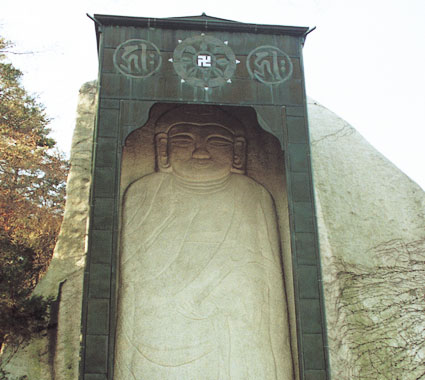- home
- Cultural Properties
- City of Seoul Designated Cultu
- Tangible Cultural Properties
- Ma Ae Stone Buddha at Doseonsa Temple
Ma Ae Stone Buddha at Doseonsa Temple

Ma Ae Stone Buddha at Doseon Temple
- Registered No Registered Tangible Cultural Properties, No.34, Seoul
- Date of Designation September 5, 1977
- Era Joseon Dynasty
- Size/Style bheight of statue 8.43m
- Material Granite
- Ownership and Maintenance Doseonsa Temple Hwagyesa Temple, Buddhist Jogye of Korea Buddhism
- Location San 264 Doseonsa Temple Ui-dong Gangbuk-gu Seoul
The Buddha Statue of Doseonsa Temple is a massive Buddha carved slightly into the 20m tall rock behind the Daeungjeon Temple of Doseonsa Temple, which is located in the halfway point of Bukhansan Mountain. It is currently protected inside a quadrangle guard made of bronze, with a stone pagoda and stone lantern in front of it. It is said that in the 2nd year of King Gyeongmun’s reign during the United Shilla Period (862), Monk Doseonguksa predicted that Buddhism would rise up once more 1,000 years later during the Malbeop Period according to feng shui.
As such, he built the temple and used his hands to cut a large rock and carve this statue of the Buddha on it. However, in actuality, this Buddha statue’s characteristics look to be from the middle of the Joseon Period. Near the end of the Joseon Period, in the 14th year of King Cheoljong’s reign (1863), Kim Jwa-geun repaired the temple, and the Chilseong House was newly built as the temple was being repaired.
In the 14th year of King Gojong’s rein (1887), Monk Imjun erected a 5-story stone pagoda enshrining Sakyamuni and small crystals from the cremated remains of marks that were regarded as sacred relics. Additionally, in the middle of the 19th century, Monk Hyemyeong repaired various palaces, including Daeungjeon Temple, and in 1904, it was designated as a National Prayer Site. More recently, the temple’s influence has spread after Monk Cheongdam became the chief priest. Currently, Hogukchamhoewon, Baekun House, Myeongbujeon, Samseonggak, and Yosachae are arranged around Daeungjeon Temple.
* Source : Website from the Bureau of Cultural Properties of Seoul

